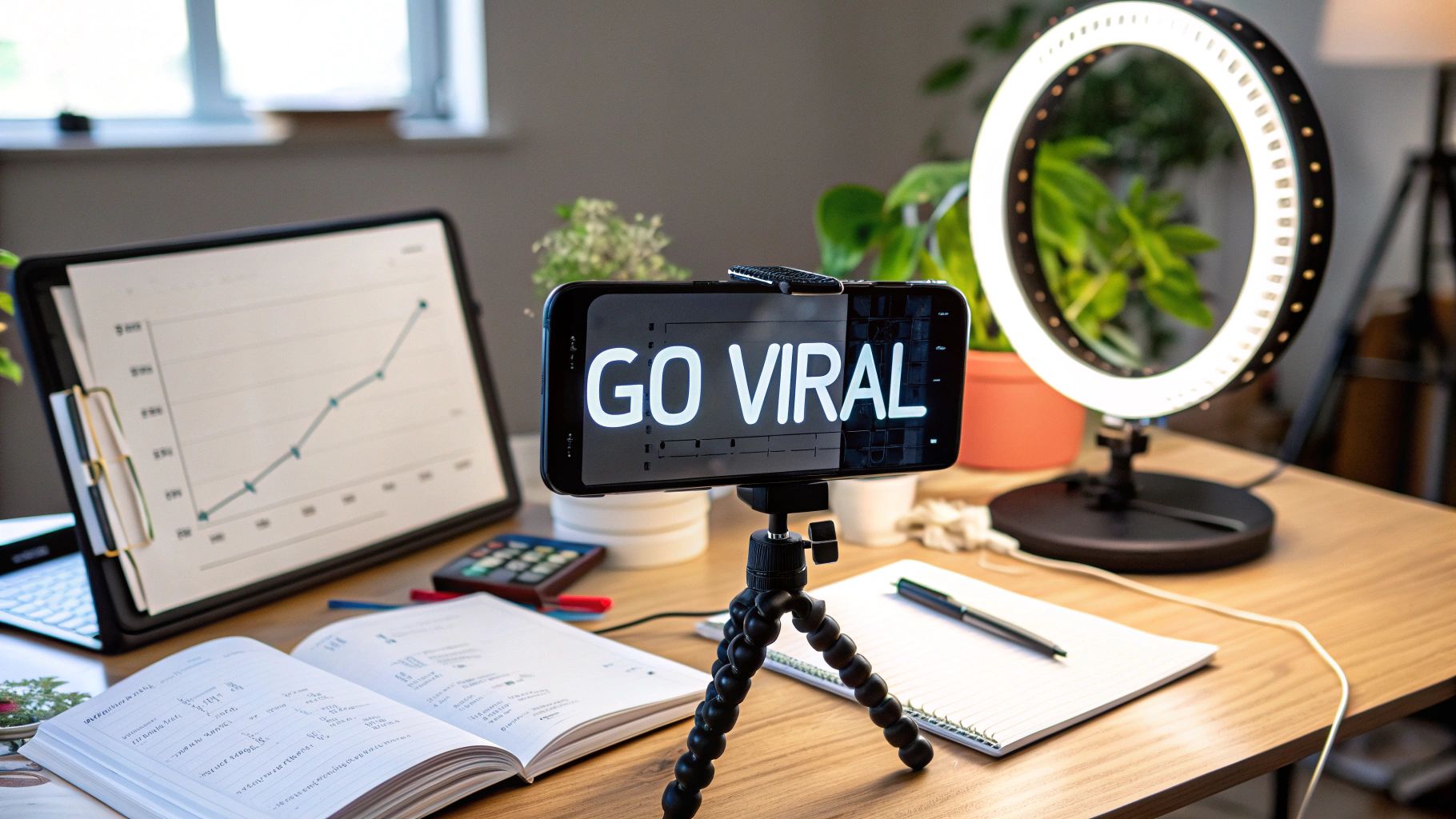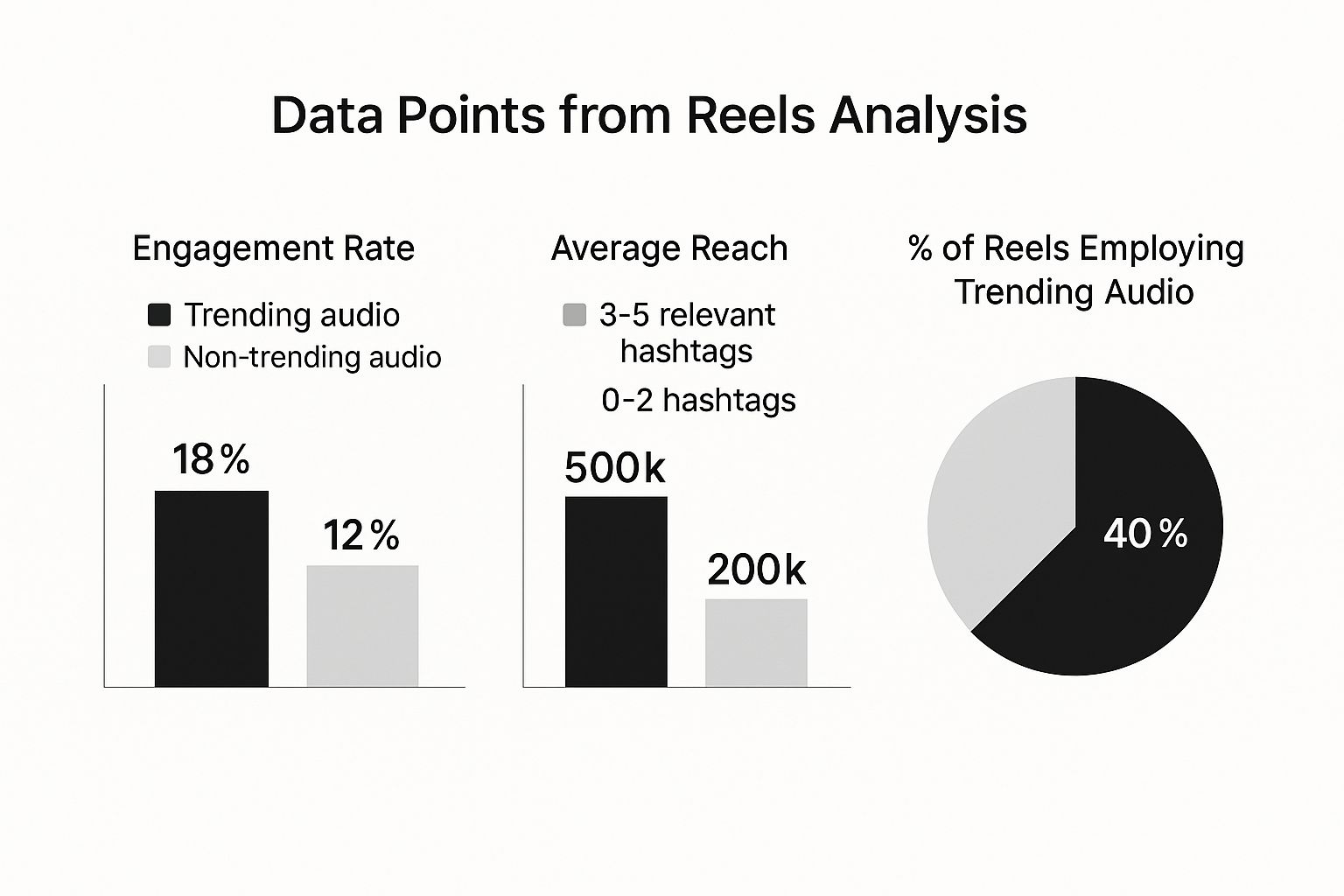Questions & Answers
We're here to help you get the most out of viral.app.
Mike Schneider
Co-Founder
Uncover the psychology and data-driven tactics behind viral Instagram Reels and build a repeatable system for growth.

To figure out how to make Reels go viral, you need to do more than just follow a few quick tips. You have to get into the nitty-gritty of what makes people stop scrolling, hit share, and engage. Virality isn’t some random lottery win; it’s a mix of psychology, understanding the algorithm, and making smart content choices. Think of it less like hoping for a lucky break and more like being a chef who knows exactly which ingredients create an amazing meal.
The Instagram algorithm itself is built to find and push content that keeps people on the app longer. And this format is becoming impossible to ignore. Projections show that Instagram Reels could capture 35% of total user time on the platform by 2025, reaching an audience of nearly 727 million users. This shows just how much potential there is for creators who really get the format right.
Deep down, a viral Reel makes a connection with someone, either emotionally or intellectually. It might teach them something, make them laugh, inspire them, or just make them feel understood. That connection is the trigger that makes them tap the share button.
For instance, a Reel demonstrating a little-known kitchen hack isn't just a tip; it's a piece of social currency. Sharing it makes the person look smart and helpful to their network. A relatable skit about the struggles of working from home works because it taps into a shared, universal experience. The best creators are masters at finding these human triggers and packing them into short, compelling videos.
While every niche has its own unique style, certain content formulas just work, time and time again. By looking at what’s already successful, we can spot repeatable patterns that signal value to both viewers and the algorithm. The idea isn't to copy someone else’s content but to adapt their winning frameworks to your own voice and topic.
To help you see how different types of content tap into specific viral triggers, I’ve put together this comparison table. It breaks down the most common Reel formats and what makes each of them work so well.
| Content Type | Viral Triggers | Average Engagement | Best Timing |
|---|---|---|---|
| Tutorial / How-To | Education, Problem-Solving, Utility | High (especially Saves) | Weekday mornings, Lunch breaks |
| Transformation | Awe, Inspiration, Satisfaction | Very High (Shares & Comments) | Weekends, Evenings |
| Relatable Humor | Comedy, Validation, Community | High (Shares & Likes) | End of workday, Weekends |
| Storytelling | Curiosity, Emotion, Suspense | High (Watch Time & Comments) | Evenings, Late night |
As the table shows, the "why" behind a viral Reel changes depending on the format. A tutorial goes viral because it's useful, while a relatable comedy sketch goes viral because it builds a sense of community. Understanding these differences is key to planning content that actually has a shot at taking off.
Ultimately, cracking the code means changing your approach from just "making another video" to strategically creating a moment your audience feels an urge to share.

Your Reel's fate is often sealed in less time than it takes to blink. On a platform built for infinite scrolling, those first three seconds are your entire audition. This isn't just about a flashy opening; it's about creating a "pattern interrupt"—something that jars a viewer's thumb to a halt. You have to pose a question, spark intense curiosity, or deliver a visual shock that makes them pause.
This is where the magic of video really shines. While all content on Instagram has its place, short-form video consistently proves it's the champion of grabbing and keeping attention. The numbers don't lie: Reels boast an average engagement rate of about 1.23%, which easily beats photos (0.70%) and carousels (0.99%). This boost in engagement comes from the format's power to serve up a compelling hook right away. You can find more details on how Reels stack up against other formats in this detailed statistical breakdown.
The perfect hook is a mix of visual candy and psychological bait. It needs to instantly tell the viewer what the video is about and give them a reason to stick around. Just think about what makes you stop scrolling. Is it a surprising claim splashed across the screen, a breathtaking clip, or a problem you can instantly relate to?
Here are a few hook strategies that have worked for me across different niches:
Your hook has to be an honest preview of your video's content. Using a bait-and-switch opener will only tick off your viewers, leading to a high drop-off rate. That kind of behavior signals to the algorithm that your Reel isn't delivering value. If you’re sharing a recipe, start with a drool-worthy shot of the finished dish. If you're telling a story, jump in at the most intense moment.
As you work on perfecting your Reel's opening and overall quality, looking into new tools can give you a real advantage. This helpful AI Video Editing Guide offers some great ideas on how technology can help you create polished and captivating hooks that feel authentic.

You’ve probably heard the generic advice to "post at 9 AM, 12 PM, and 5 PM." While that’s not a terrible place to start, it's far from the secret sauce that makes Reels go viral. The real magic happens when you stop asking when people are online and start asking why they’re online at that moment. It's all about matching your content’s vibe to your audience's current mindset.
Think about it from your own experience. The version of you scrolling through Reels on a lunch break is looking for something different than the you who’s winding down before bed. The lunchtime scroller wants a quick laugh or a neat trick. The late-night viewer is often more open to longer, more captivating stories. This is the psychological shift you need to make. You're not just chasing peak hours; you're targeting peak mindsets.
Your Instagram Insights are a goldmine of clues about your audience's daily life. When you look at the "Most Active Times" chart, don't just see the spikes. Look for the story behind them. Are your followers a bunch of night owls, or are they early risers? Do they engage more during the work week or on weekends? This data gives you a solid baseline.
With that baseline, you can begin to form and test hypotheses. You might notice that your educational Reels get more traction on Tuesday mornings when people are in a productive headspace. In contrast, your funnier, more relatable content might blow up on Friday afternoons as everyone's mood lightens for the weekend.
Here’s a practical way to think about it:
Once you find a posting time that seems to work, consistency is your greatest ally. The Instagram algorithm responds well to predictable patterns. When you consistently post at times your audience is most engaged, you're essentially training the algorithm to have an audience ready and waiting for your content. This creates a powerful, positive feedback loop.
This doesn't mean you need to post every single day. Publishing three high-quality Reels per week at your proven peak times is much more effective than dropping seven mediocre ones at random hours. Quality combined with strategic timing sends a clear signal that your content is valuable. This is a fundamental part of learning how to make Reels go viral—it's about building momentum, one well-timed Reel at a time.
A Reel doesn't just "go viral" because it hits a certain view count. True virality happens when the engagement starts a chain reaction, feeding on itself. Think of it like a snowball rolling downhill. The first few comments and shares give it a nudge, but the real momentum builds when those interactions inspire more people to engage. Your job is to pack that initial snowball so it picks up speed on its own. This means creating content that doesn't just ask for engagement but naturally invites it.
The secret is to move past generic calls to action like "Comment below!" and instead create prompts that feel like real conversation starters. To get your Reels to really pop, you need to use proven strategies to boost social media engagement. This is how you turn your comments section from a suggestion box into a buzzing community space.
Instead of asking a simple yes-or-no question, try posing a fun dilemma or sharing a relatable "unpopular opinion" that people can't resist responding to. For example, rather than "Do you like this outfit?" go with, "Unpopular opinion: This is the only way to style this jacket. Agree or disagree?" This small change transforms a simple ask into a lively debate, which can dramatically increase your comment count and, more importantly, create comment threads.
When someone replies, don't just tap the "like" button and move on. Answer them with a follow-up question. This makes the original commenter feel heard and encourages others to jump into the chat. Every single reply signals to the Instagram algorithm that your content is generating a meaningful discussion—a huge indicator of its value.
Shares and saves are the gold standard of engagement. They tell the algorithm your content is so good that people want to either keep it for later or show it to their friends. To encourage these actions, think about your content's practical use and social value.
Before we get into specific tactics, it's helpful to see how different engagement strategies perform. The table below compares a few common approaches and their effect on getting your content noticed by the algorithm.
| Strategy | Engagement Boost | Shareability Factor | Algorithm Preference |
|---|---|---|---|
| Posing Debates | High (Drives comment threads) | Medium | High |
| "Save this for later" Prompts | Medium (Encourages saves) | Low | Medium |
| Relatable Humor/Skits | High (Drives shares & comments) | High | Very High |
| Tutorials & How-Tos | High (Drives saves & comments) | Medium | High |
| Generic "Comment below!" | Low (Low-effort responses) | Very Low | Low |
As you can see, strategies that create conversation and relatability are favored heavily by the algorithm. Simply asking for a comment isn't enough; you need to give people a compelling reason to participate.
The infographic below shows how elements like trending audio and hashtags directly fuel the viral cycle by boosting the reach and engagement of your Reel.

The data makes it clear: strategic choices like using popular audio and the right hashtags aren't just minor adjustments. They are powerful tools for increasing both engagement and overall reach.

It's easy to think that the secret to going viral is just jumping on every new trend. But chasing trends often means losing the very thing that makes your content special: you. The most successful creators find a sweet spot where they use trends as a launchpad for their unique message, not as a script to follow. The real goal isn't just to participate but to adapt trends in a way that feels true to your brand.
The trick is to catch trends early and then filter them through your own creative lens. A great place to hunt for what's next is TikTok, as popular audio and formats usually make their way to Instagram a week or two later. When you're searching for a trending audio, aim for ones with fewer than 15,000 uses. This is the prime window where you can still rank on the audio’s page before it's everywhere.
But just using the sound isn’t enough. Before you hit record, take a moment and ask yourself, "How can I make this mine?"
This way, your content stays fresh and original, and your feed doesn't end up looking like a clone of everyone else's.
Instead of just following the crowd, why not become a source of inspiration for your own community? You can do this by creating original, high-value content that solves a real problem or connects with an experience that's unique to your audience. When you post a Reel that's genuinely helpful or deeply relatable, you’re not just making a video—you're potentially creating a whole new format.
Think about a DIY expert who starts a "30-second home repair" series. Soon enough, their followers might start making their own quick-fix videos using that same structure. That's how you go from being a trend follower to a trendsetter. By consistently putting your own spin on what’s popular and creating valuable original content, you build an audience that follows you for you, not just for the trending sound of the week. That authentic connection is the real foundation for lasting growth and virality.
Success on Instagram isn't about luck; it's about learning from every single Reel you post. The real secret to consistently creating viral content is figuring out what your audience loves and why. This means you have to go beyond surface-level stats like views and likes and dig into the data that actually hints at viral potential.
Think of it this way: a Reel with 100,000 views but terrible watch time is just a flash in the pan. On the other hand, a Reel with 20,000 views that gets tons of shares, saves, and has a high average watch time? That’s the one with the real ingredients for explosive growth.
If you want to figure out how to make reels go viral, you need to play detective, and your Instagram Insights is the scene of the crime. The most important clues aren't always the most obvious ones. While it's satisfying to see a high view count, the metrics that really tell the algorithm your content is valuable are a bit different.
Your most successful Reels aren't just one-off hits; they're roadmaps. It’s smart to create a simple system to track how your content performs. You could use a basic spreadsheet to log each Reel and note its key metrics after 24 hours, and then again after a week. While a spreadsheet is a good start, dedicated tools can automate this process. For instance, the viral.app analytics dashboard uses AI to surface deep insights, helping you uncover your winning formula faster.
Start looking for patterns. Do Reels with a bold text hook in the first three seconds outperform those without one? Does a specific trending audio consistently lead to more shares? By systematically analyzing your content, you can stop guessing what might work and start knowing what will work. This data-driven approach lets you double down on your wins and learn from the Reels that fall flat, turning every post into a valuable lesson.
Trying to remember and apply all these strategies at once can feel like a lot, I get it. The secret isn't about making one perfect video that blows up. It’s about building a repeatable system—turning these tactics into simple habits that lead to consistent growth over time. This roadmap breaks it all down into a concrete action plan for your daily, weekly, and monthly workflow.
Your daily habits are the building blocks of viral success. The idea is to make content creation and engagement feel like second nature, not a chore. On a weekly basis, you'll focus on creating content more efficiently and figuring out what’s actually connecting with your audience.
Once a month, it's time to zoom out and look at the bigger picture. This is when you'll fine-tune your entire strategy based on the broader trends you see in your data. It's also the perfect moment to troubleshoot what isn't working.
If a Reel flops, don’t just archive it and forget. Analyze it. Was the hook too weak to stop the scroll? Did the audio choice feel a little off for the video's vibe? Maybe you posted it at a time when your audience was offline. Treating every underperforming video as a learning opportunity is how you get better. Every single video, good or bad, gives you data that turns random luck into a predictable system.
Ready to take the guesswork out of your analytics? viral.app gives you the deep insights needed to understand your performance and make data-backed decisions that drive real growth.
We're here to help you get the most out of viral.app.
Become an expert in UGC marketing today leveraging our industry knowledge and unique tools.